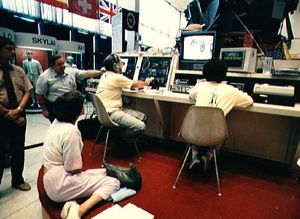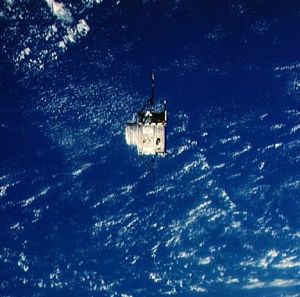
Home - Search - Browse - Alphabetic Index: 0- 1- 2- 3- 4- 5- 6- 7- 8- 9
A- B- C- D- E- F- G- H- I- J- K- L- M- N- O- P- Q- R- S- T- U- V- W- X- Y- Z
STS-51-F

STS-51-F
Launch of the STS 51-F Challenger
Credit: NASA
AKA: Challenger;Spacelab 2. Launched: 1985-07-29. Returned: 1985-08-06. Number crew: 7 . Duration: 7.95 days.
Payloads: Spacelab-2 with 13 experiments, Shuttle Amateur Radio Experiment (SAREX), Protein Crystal Growth (PCG). The flight crew was divided into a red and blue team. Each team worked 12-hour shifts for 24-hour-a-day operation.
Orbits of Earth: 126. Distance traveled: 5,284,350 km. Orbiter Liftoff Mass: 114,590 kg. Orbiter Mass at Landing: 98,307 kg. Payload to Orbit: 15,603 kg. Payload Returned: 15,603 kg. Landed at: Runway 23 dry lake bed at Edwards Air Force Base, . Landing Speed: 368 kph. Touchdown miss distance: 1,131 m. Landing Rollout: 2,611 m.
NASA Official Mission Narrative
Mission Name: 51-F (19)
CHALLENGER (8)
Pad 39-A (31)
19th Shuttle mission
8th Flight OV-099
RSLS Abort after SSME Ignition (2)
Abort-to orbit (1)
Extended mission
Crew:
Gordon Fullerton (2), Commander
Roy D. Bridges (1), Jr., Pilot
F. Story Musgrave (2), Mission Specialist 1
Anthony W. England (1), Mission Specialist 2
Karl G. Henize (1), Mission Specialist 3
Loren W. Acton (1), Payload Specialist 1
John-David F. Bartoe (1), Payload Specialist 2
Milestones:
OPF - May 12,1985
VAB - June 24, 1985
PAD - June 29, 1985
Payload:
SPACELAB-2,SAREX(1),CBDE,PGU
Mission Objectives:
The Spacelab-2 payload consisted of an igloo and three pallets in the payload bay, containing scientific instruments dedicated to life sciences, plasma physics, astronomy, high-energy astrophysics, solar physics, atmospheric physics and technology research.
A major objective of the mission was to verify the performance of the Spacelab systems with the orbiter as well as to measure the environment created by the vehicle in space.
Launch:
July 29, 1985, 5:00:00 p.m. EDT. Launch countdown July 12 halted at T-3 seconds after main engine ignition when a malfunction of number two Space Shuttle Main Engine (SSME) coolant valve caused shutdown of all three main engines. Launch July 29 delayed one hour, 37 minutes due to problem with table maintenance block update uplink. Five minutes, 45 seconds into ascent, number one main engine shutdown prematurely, resulting In an Abort To Orbit (ATO) trajectory. Launch Weight: 252,855 lbs.
Orbit:
Altitude: 173nm
Inclination: 49.5 degrees
Orbits: 127
Duration: 7 days, 22 hours, 45 minutes; 26 seconds.
Distance: 3,283,543 miles
Hardware:
SRB: BI-017
SRM: M019(HPM)
ET : 19/LWT-12
MLP : 2
SSME-1: SN-2023
SSME-2: SN-2020
SSME-3: SN-2021
Landing:
August 6, 1985, 12:45:26 p.m. PDT, Runway 23, Edwards Air Force Base, Calif. Rollout distance: 8,569 feet. Rollout time: 55 seconds. Mission extended 17 revolutions for additional payload activities due to abort-to-orbit. Orbiter returned to KSC Aug. 11, 1985. Landing Weight: 216,735 lbs.
Mission Highlights:
Primary payload was Spacelab-2. Despite abort-to-orbit, which required mission replanning, mission declared success. Special part of modular Spacelab system, the Igloo, located at head of three-pallet train, provided on-site support to instruments mounted on pallets. Main mission objective was to verify performance of Spacelab system sand determine interface capability of orbiter, and measure environment induced by spacecraft. Experiments covered life sciences, plasma physics, astronomy, high energy astrophysics, solar physics, atmospheric physics and technology research.
The flight marked the first time the ESA Instrument Pointing System (IPS) was tested in orbit. This unique experiment pointing enstrument was designed with an accuracy of one arc second. Initially, some problems were experienced when it was commanded to track the Sun. A series of software fixes were made and the problem was corrected.
More at: STS-51-F.
Family: Manned spaceflight. People: Acton, Bartoe, Bridges, England, Fullerton, Henize, Musgrave. Country: USA. Spacecraft: Challenger. Projects: STS. Launch Sites: Cape Canaveral. Agency: NASA, NASA Houston.
 | STS-51-F Kathleen England watches her image transmitted to shuttle Credit: NASA |
 | STS-51-F View of Spacelab 2 pallet in the open payload bay Credit: NASA |
 | STS-51-F Southern Italy, Instrument Pointing Subsystem Credit: NASA |
 | STS-51-F View of the Challenger's payload bay and the SOUP experiment Credit: NASA |
 | STS-51-F View of the Plasma Diagnostics Package (PDP) Credit: NASA |
 | STS-51-F Astronaut Anthony W. England with soft drink in middeck area near galley Credit: NASA |
 | STS-51-F Landing of the Shuttle Challenger at Edwards AFB and end of STS 51-F mission Credit: NASA |
1985 July 12 - . Launch Site: Cape Canaveral. Launch Complex: Cape Canaveral LC39A. LV Family: Shuttle. Launch Vehicle: Space Shuttle.
- Shuttle Challenger Pad Abort - . Nation: USA. Program: STS. Flight: STS-51-F. Spacecraft Bus: Shuttle. Spacecraft: Challenger. The countdown for Challenger's launch was halted at T-3 seconds when on-board computers detected a problem with a coolant valve on main engine #2. The valve was replaced and Challenger was launched on July 29, 1985..
1985 July 29 - . 21:00 GMT - . Launch Site: Cape Canaveral. Launch Complex: Cape Canaveral LC39A. Launch Platform: MLP2. LV Family: Shuttle. Launch Vehicle: Space Shuttle.
- STS-51-F - .
Call Sign: Challenger. Crew: Acton,
Bartoe,
Bridges,
England,
Fullerton,
Henize,
Musgrave.
Payload: Challenger F08 / PDP / Spacelab 2 PLT. Mass: 15,603 kg (34,398 lb). Nation: USA.
Related Persons: Acton,
Bartoe,
Bridges,
England,
Fullerton,
Henize,
Musgrave.
Agency: NASA Houston.
Program: STS.
Class: Manned.
Type: Manned spaceplane. Flight: STS-51-F.
Spacecraft Bus: Shuttle.
Spacecraft: Challenger.
Duration: 7.95 days. Decay Date: 1985-08-06 . USAF Sat Cat: 15925 . COSPAR: 1985-063A. Apogee: 337 km (209 mi). Perigee: 203 km (126 mi). Inclination: 49.50 deg. Period: 89.90 min.
Manned seven crew. At 5 minutes, 45 seconds into ascent the number one engine shut down prematurely due to a a sensor problem and an abort to orbit was declared. Despite the anomaly the mission continued. Launched PDP; carried Spacelab 2. Payloads: Spacelab-2 with 13 experiments, Shuttle Amateur Radio Experiment (SAREX), Protein Crystal Growth (PCG). The flight crew was divided into a red and blue team. Each team worked 12-hour shifts for 24-hour-a-day operation.
1985 August 6 - .
- Landing of STS-51-F - . Return Crew: Acton, Bartoe, Bridges, England, Fullerton, Henize, Musgrave. Nation: USA. Related Persons: Acton, Bartoe, Bridges, England, Fullerton, Henize, Musgrave. Program: Spacelab. Flight: STS-51-F. STS-51-F landed at 19:52 GMT. .
Back to top of page
Home - Search - Browse - Alphabetic Index: 0- 1- 2- 3- 4- 5- 6- 7- 8- 9
A- B- C- D- E- F- G- H- I- J- K- L- M- N- O- P- Q- R- S- T- U- V- W- X- Y- Z
© 1997-2019 Mark Wade - Contact
© / Conditions for Use